

GARLIC MUSTARD
Alliaria petiolata
Biology



Quick Removal Tips
Identification
Look-Alikes
Technique
Notes of Interest
Garlic Mustard Recipe
|
GARLIC MUSTARD
|

|
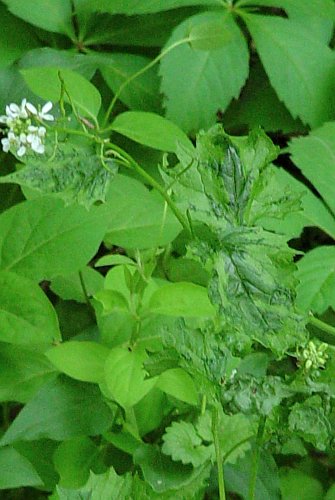 Seven kinds of fungus attack garlic mustard in Europe, and several viruses. The pathogen creating mottled leaves here did not prevent flowering. One virus in Ottawa is known to prevent seeding (tncweeds.ucdavis.edu/esadocs/allipeti.html), but more hope is being placed in certain insects. The difficulty is in finding a species that will die rather than eat other mustard species.
Seven kinds of fungus attack garlic mustard in Europe, and several viruses. The pathogen creating mottled leaves here did not prevent flowering. One virus in Ottawa is known to prevent seeding (tncweeds.ucdavis.edu/esadocs/allipeti.html), but more hope is being placed in certain insects. The difficulty is in finding a species that will die rather than eat other mustard species.
 A different pathogen caused a pebbly leaf appearance. Testing for biological control generally takes five to ten years or more, and most research addresses plants of greater agricultural importance than garlic mustard. (Photo probably from the University of California Davis website above.)
A different pathogen caused a pebbly leaf appearance. Testing for biological control generally takes five to ten years or more, and most research addresses plants of greater agricultural importance than garlic mustard. (Photo probably from the University of California Davis website above.)
|
Another pathogen caused furled leaf edges.
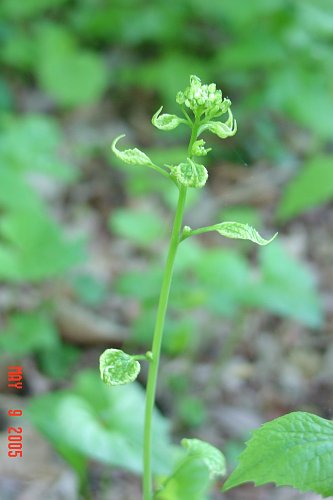
|
The cause of this deformed seed pod found near
Gridley Lane, close to University, is unknown. 
|


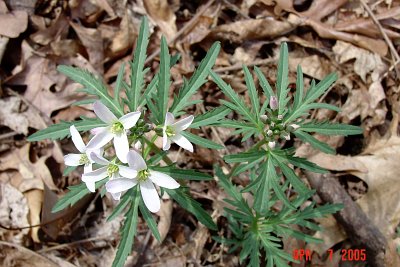 Cut-leaved toothwort, a native wildflower in the mustard family. The rare West Virginia white butterfly feeds on toothworts (probably not our species, though). Where garlic mustard has moved in, the butterfly lays eggs on the invasive plant instead. Chemicals in garlic mustard seem toxic to the eggs of the butterfly, and eggs fail to hatch.
Cut-leaved toothwort, a native wildflower in the mustard family. The rare West Virginia white butterfly feeds on toothworts (probably not our species, though). Where garlic mustard has moved in, the butterfly lays eggs on the invasive plant instead. Chemicals in garlic mustard seem toxic to the eggs of the butterfly, and eggs fail to hatch.
tncweeds.ucdavis.edu/esadocs/allipeti.html
www.nps.gov/plants/alien/fact/alpe1.htm
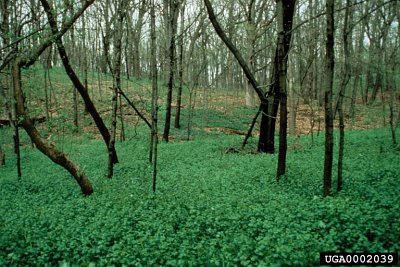 In some states such as Illinois garlic mustard has taken off in high quality forests to form a solid-looking ground cover. With so many plants, the option is to spray or recruit an untold number of volunteers.
In some states such as Illinois garlic mustard has taken off in high quality forests to form a solid-looking ground cover. With so many plants, the option is to spray or recruit an untold number of volunteers.
Early research seemed to show that sinigrin and other root chemicals inhibit the growth of grasses and some herbs, explaining how the plant can become dominant. More recent research raised questions about earlier work. Nonetheless, the fact that garlic mustard can take over woods should give impetus to ridding Sligo of all garlic mustard immediately!! www.se-eppc.org/manual/garlicmustard.html Photo by Victoria Nuzzo.
Researcher Victoria Nuzzo has studied garlic mustard more closely than anyone else, to judge from website references. She writes, "Alliaria petiolata invades forested communities and edge habitats. The plant has no known natural enemies in North America, is self-fertile, and is difficult to eradicate once established. Thus, the best and most effective control method for Alliaria petiolata is to prevent its initial establishment."
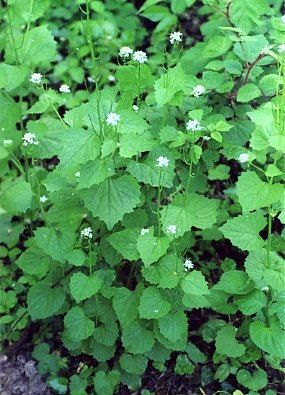
In May petals gradually fall from many plants, making them easy to miss.
June is perhaps the best time to collect, provided you will have time before seeds fall.
Flowers are gone, but the yellowing leaves are just as conspicuous. All plants are mature, and it seems unlikely new stems will grow if you miss the root. But the season is nearly over.